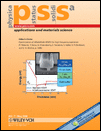Morphology and microstructure of a -plane GaN layers grown by MOVPE and by low pressure solution growth (LPSG)
Abstract
In this paper a -plane GaN-layers, grown by two different techniques are compared, mainly focusing on the surface morphology and microstructure of the samples: Layers grown by metal organic vapor phase epitaxy (MOVPE) exhibit a flat surface interrupted by a certain number of pits with triangular shape. In contrast, specimens processed by LPSG developed a rough surface with a roof like morphology. The morphology is discussed in view to the facetting behaviour of the GaN. The observed thickness of the layers implies, that growth in this direction is slightly faster compared to the regular c -plane growth. TEM investigations showed that the microstructure of the a -plane samples is dominated by a high density of dislocations and stacking faults. In photoluminescence measurements a slightly different characteristic was seen for the materials grown by the two techniques. (© 2006 WILEY-VCH Verlag GmbH & Co. KGaA, Weinheim)




